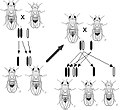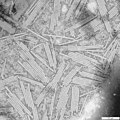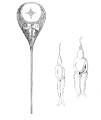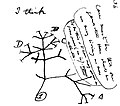
Back Portaal:Biologie Afrikaans بوابة:علم الأحياء Arabic قيسارية:لبيولوجيا ARY Portal:Biologiya Azerbaijani پوْرتال:بیوْلوْژی AZB Партал:Біялогія Byelorussian Портал:Биология Bulgarian প্রবেশদ্বার:জীববিজ্ঞান Bengali/Bangla Portal:Biologija BS Portal:Biologia Catalan
Introduction
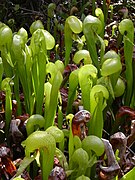

Biology is the scientific study of life. It is a natural science with a broad scope but has several unifying themes that tie it together as a single, coherent field. For instance, all organisms are made up of at least one cell that processes hereditary information encoded in genes, which can be transmitted to future generations. Another major theme is evolution, which explains the unity and diversity of life. Energy processing is also important to life as it allows organisms to move, grow, and reproduce. Finally, all organisms are able to regulate their own internal environments.
Biologists are able to study life at multiple levels of organization, from the molecular biology of a cell to the anatomy and physiology of plants and animals, and evolution of populations. Hence, there are multiple subdisciplines within biology, each defined by the nature of their research questions and the tools that they use. Like other scientists, biologists use the scientific method to make observations, pose questions, generate hypotheses, perform experiments, and form conclusions about the world around them.
Life on Earth, which emerged more than 3.7 billion years ago, is immensely diverse. Biologists have sought to study and classify the various forms of life, from prokaryotic organisms such as archaea and bacteria to eukaryotic organisms such as protists, fungi, plants, and animals. These various organisms contribute to the biodiversity of an ecosystem, where they play specialized roles in the cycling of nutrients and energy through their biophysical environment. (Full article...)
Selected article -

A prokaryote (/proʊˈkærioʊt, -ət/; less commonly spelled procaryote) is a single-cell organism whose cell lacks a nucleus and other membrane-bound organelles. The word prokaryote comes from the Ancient Greek πρό (pró), meaning 'before', and κάρυον (káruon), meaning 'nut' or 'kernel'. In the two-empire system arising from the work of Édouard Chatton, prokaryotes were classified within the empire Prokaryota. However in the three-domain system, based upon molecular analysis, prokaryotes are divided into two domains: Bacteria (formerly Eubacteria) and Archaea (formerly Archaebacteria). Organisms with nuclei are placed in a third domain: Eukaryota.
Prokaryotes evolved before eukaryotes, and lack nuclei, mitochondria, and most of the other distinct organelles that characterize the eukaryotic cell. It was once thought that prokaryotic cellular components were unenclosed within the cytoplasm except for an outer cell membrane, but bacterial microcompartments, which are thought to be quasi-organelles enclosed in protein shells (such as the encapsulin protein cages), have been discovered, along with other prokaryotic organelles. While being unicellular, some prokaryotes, such as cyanobacteria, may form colonies held together by biofilms, and large colonies can create multilayered microbial mats. Others, such as myxobacteria, have multicellular stages in their life cycles. Prokaryotes are asexual, reproducing via binary fission without any fusion of gametes, although horizontal gene transfer may take place. (Full article...)
Selected picture -

Major topics
Selected biography -
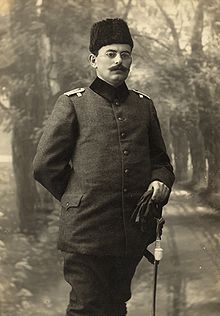
Tawfiq Canaan (Arabic: توفيق كنعان) (24 September 1882 – 15 January 1964) was a pioneering Palestinian physician, medical researcher, ethnographer, and Palestinian nationalist. Born in Beit Jala during the rule of the Ottoman Empire, he served as a medical officer in the Ottoman army during World War I.
During British rule, he served as the first President of the Palestine Arab Medical Association founded in 1944, and as the director of several Jerusalem area hospitals before, during, and after the 1948 war. Over the course of his medical career, he authored more than thirty-seven studies on topics including tropical medicine, bacteriology, malaria, tuberculosis, and health conditions in Palestine, and contributed to research that led to a cure for leprosy. (Full article...)
General images -
Did you know -
- ... that one of the smallest fish, the Philippine goby, can only grow between 1 and 1.5 cm?
- ...that the largest flower, Rafflesia has a very foul odor?
- ... that mesoporous silica nanoparticles are prepared by the Stöber process and are used in preparing biosensors and delivering medications to within cellular structures?
Things you can do
Related portals
Biology portals
Categories

Anatomy - Anthropology - Astrobiology - Biochemistry - Bioengineering - Bioinformatics - Biotechnology - Botany - Cell biology - Conservation biology - Developmental biology - Ecology - Environmental science - Evolutionary biology - Genetics - Mathematical biology - Medicine - Microbiology - Immunology - Molecular biology - Mycology - Neuroscience - Paleontology - Palynology Parasitology - Pharmacology -
Phylogenetics - Physiology - Systems biology - Taxonomy - Toxicology - Virology - ZoologyMore topics
WikiProjects

WikiProjects connected with biology:
A complete list of scientific WikiProjects can be found here. See also Wikispecies, a Wikimedia project dedicated to classification of biological species.
Associated Wikimedia
The following Wikimedia Foundation sister projects provide more on this subject:
-
Commons
Free media repository -
Wikibooks
Free textbooks and manuals -
Wikidata
Free knowledge base -
Wikinews
Free-content news -
Wikiquote
Collection of quotations -
Wikisource
Free-content library -
Wikiversity
Free learning tools -
Wiktionary
Dictionary and thesaurus


